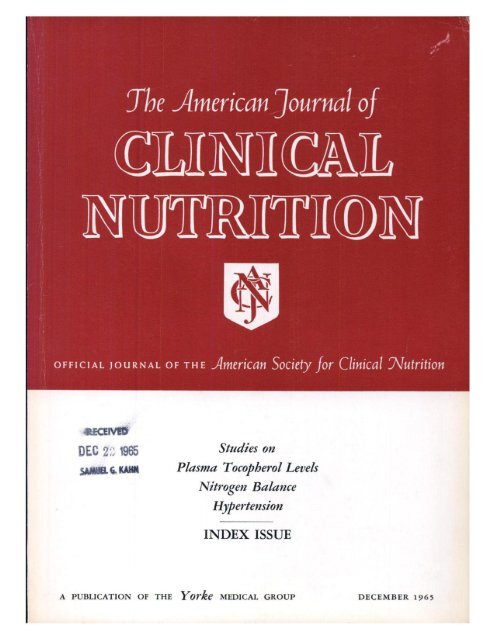Empirical dietary index for lower urate concentrations and risk of gout: evidence from cohort studies
IF 6.9
1区 医学
Q1 NUTRITION & DIETETICS
引用次数: 0
Abstract
Background
High blood urate concentrations are a causal risk factor for the development of gout. There is no dietary pattern that specifically targets on lowering plasma urate concentrations or gout risk.
Objectives
This study aimed to derive a dietary pattern that predicts lower plasma urate concentrations and to examine this diet in relation to the risk of gout and related cardiometabolic conditions, including hypertension, coronary artery disease (CAD), stroke, and type 2 diabetes (T2D).
Methods
An Empirical Dietary Index for Normo-Uricemia (EDINU) was developed using 7-d diet records and plasma urate concentrations in the Lifestyle Validation Study (LVS) and prospective associations between the EDINU and disease risks were assessed using multivariable Cox regression in the Nurses' Health Study (NHS) and Health Professionals Follow-up Study (HPFS), using prospective cohort data. Replications were conducted in National Health and Nutrition Examination Survey (NHANES) and UK Biobank.
Results
The EDINU positively ranks low-fat milk, blueberries, grapes, and cheese as negative predictors of urate and negatively ranks mixed vegetables, liquor, red meat, liver, artificially sweetened beverages, tomato products, wine, and salad dressing as positive predictors. The EDINU showed significant correlations with plasma urate concentrations in both discovery and replication studies (Spearman correlation of –0.23 in LVS or –0.33 in NHANES). Higher EDINU scores were associated with lower gout risk in 3 independent cohort studies with a hazard ratio, comparing extreme quintiles, of 0.48 (95% confidence interval: 0.42, 0.55) in the NHS/HPFS or 0.65 (0.48, 0.88) in UK Biobank. The EDINU was inversely associated with a lower risk of hypertension, stroke, and T2D, but not CAD, in the NHS/HPFS.
Conclusions
A replicated empirical index predicting lower plasma urate is associated with significantly lower risks of gout and related cardiometabolic conditions. Consuming such a diet with lower uricemic potentials could be a novel, promising approach to preventing gout.
低尿酸水平和痛风风险的经验饮食指数:来自队列研究的证据。
背景:高血尿酸水平是痛风发展的一个因果危险因素。目前还没有专门针对降低血浆尿酸水平或痛风风险的饮食模式。目的:得出一种饮食模式,预测较低的血浆尿酸水平,并检查这种饮食与痛风和相关心脏代谢疾病(包括高血压、冠心病、中风和2型糖尿病)风险的关系。方法:使用生活方式验证研究(LVS)中的7天饮食记录和血浆尿酸水平,制定了正常尿血症的经验饮食指数(EDINU),并使用前瞻性队列数据,在护士健康研究(NHS)和卫生专业人员随访研究(HPFS)中使用多变量Cox回归评估了EDINU与疾病风险之间的前瞻性关联。在NHANES和UK Biobank中进行了重复。结果:EDINU将低脂牛奶、蓝莓、葡萄和奶酪列为尿酸盐的负面预测因素,将混合蔬菜、白酒、红肉、肝脏、人工加糖饮料、番茄制品、葡萄酒和沙拉酱列为尿酸盐的负面预测因素。在发现和重复研究中,EDINU与血浆尿酸水平均显示出显著相关性(Spearman相关性在LVS中为-0.23,在NHANES中为-0.33)。在三个独立队列研究中,较高的EDINU评分与较低的痛风风险相关,比较极端五分位数的风险比,NHS/HPFS为0.48 (95% CI: 0.42, 0.55), UK Biobank为0.65(0.48,0.88)。在NHS/HPFS中,EDINU与较低的高血压、中风和T2D风险呈负相关,但与冠心病无关。结论:一个重复的经验指数预测较低的血浆尿酸与痛风和相关心脏代谢疾病的风险显著降低相关。食用这种具有较低尿酸潜能的饮食可能是一种新的、有希望的预防痛风的方法。
本文章由计算机程序翻译,如有差异,请以英文原文为准。
求助全文
约1分钟内获得全文
求助全文
来源期刊
CiteScore
12.40
自引率
4.20%
发文量
332
审稿时长
38 days
期刊介绍:
American Journal of Clinical Nutrition is recognized as the most highly rated peer-reviewed, primary research journal in nutrition and dietetics.It focuses on publishing the latest research on various topics in nutrition, including but not limited to obesity, vitamins and minerals, nutrition and disease, and energy metabolism.
Purpose:
The purpose of AJCN is to:
Publish original research studies relevant to human and clinical nutrition.
Consider well-controlled clinical studies describing scientific mechanisms, efficacy, and safety of dietary interventions in the context of disease prevention or health benefits.
Encourage public health and epidemiologic studies relevant to human nutrition.
Promote innovative investigations of nutritional questions employing epigenetic, genomic, proteomic, and metabolomic approaches.
Include solicited editorials, book reviews, solicited or unsolicited review articles, invited controversy position papers, and letters to the Editor related to prior AJCN articles.
Peer Review Process:
All submitted material with scientific content undergoes peer review by the Editors or their designees before acceptance for publication.

 求助内容:
求助内容: 应助结果提醒方式:
应助结果提醒方式:


